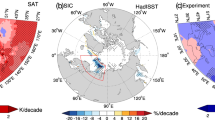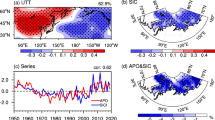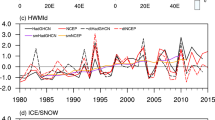Abstract
The Tibetan Plateau (TP) has recently been polluted by anthropogenic emissions transported from South Asia, but the mechanisms conducive to this aerosol delivery are poorly understood. Here we show that winter loss of Arctic sea ice over the subpolar North Atlantic boosts aerosol transport toward the TP in April, when the aerosol loading is at its climatological maximum and preceding the Indian summer monsoon onset. Low sea ice in February weakens the polar jet, causing decreased Ural snowpack via reduced transport of warm, moist oceanic air into the high-latitude Eurasian interior. This diminished snowpack persists through April, reinforcing the Ural pressure ridge and East Asian trough, segments of a quasi-stationary Rossby wave train extending across Eurasia. These conditions facilitate an enhanced subtropical westerly jet at the southern edge of the TP, invigorating upslope winds that combine with mesoscale updrafts to waft emissions over the Himalayas onto the TP.
This is a preview of subscription content, access via your institution
Access options
Access Nature and 54 other Nature Portfolio journals
Get Nature+, our best-value online-access subscription
$29.99 / 30 days
cancel any time
Subscribe to this journal
Receive 12 print issues and online access
$209.00 per year
only $17.42 per issue
Buy this article
- Purchase on Springer Link
- Instant access to full article PDF
Prices may be subject to local taxes which are calculated during checkout





Similar content being viewed by others
Data availability
The in situ meteorological data at Nam Co and QOMS43,44 are available from the Institute of Tibetan Plateau Research on reasonable request. The in situ meteorological data at the 66 TP stations are available from the National Climate Centre, China Meteorological Administration, on reasonable request. The ERA-Interim/Land reanalysis data (a version without precipitation correction)47 is available from the European Centre for Medium-Range Weather Forecasts on request. The following publicly available data sources were used in this study: AERONET (ref. 42), https://aeronet.gsfc.nasa.gov; HadISST (ref. 45), https://www.metoffice.gov.uk/hadobs/hadisst2; ERA-Interim (ref. 46), https://www.ecmwf.int/en/forecasts/datasets/reanalysis-datasets/era-interim; MODIS Aqua (ref. 48), https://giovanni.gsfc.nasa.gov/giovanni. Source data are provided with this paper.
Code availability
All graphics were produced using NCAR Command Language v.6.40 (https://www.earthsystemgrid.org/dataset/ncl.640.html). Scripts are available at Zenodo under the identifier https://doi.org/10.5281/zenodo.3934144.
References
Yao, T. et al. Third pole environment (TPE). Environ. Dev. 3, 52–64 (2012).
Qiu, J. China: the third pole. Nature 454, 393–396 (2008).
Xia, X. G. et al. Baseline continental aerosol over the central Tibetan Plateau and a case study of aerosol transport from South Asia. Atmos. Environ. 45, 7370–7378 (2011).
Zhu, J. et al. Spatiotemporal variation of aerosol and potential long-range transport impact over Tibetan Plateau, China. Atmos. Chem. Phys. 19, 14637–14656 (2019).
Pokharel, M. et al. Aerosol properties over Tibetan Plateau from a decade of AERONET measurements: baseline, types, and influencing factors. J. Geophys. Res. Atmos. 124, 13357–13374 (2019).
Yin, X. et al. Surface ozone at Nam Co in the inland Tibetan Plateau: variation, synthesis comparison and regional representativeness. Atmos. Chem. Phys. 17, 11293–11311 (2017).
Chen, X., Kang, S., Cong, Z., Yang, J. & Ma, Y. Concentration, temporal variation, and sources of black carbon in the Mt. Everest region retrieved by real-time observation and simulation. Atmos. Chem. Phys. 18, 12859–12875 (2018).
Wan, X. et al. Size distribution of carbonaceous aerosols at a high-altitude site on the central Tibetan Plateau (Nam Co Station, 4730 m a.s.l.). Atmos. Res. 153, 155–164 (2015).
Cong, Z. et al. Carbonaceous aerosols on the south edge of the Tibetan Plateau: concentrations, seasonality and sources. Atmos. Chem. Phys. 15, 1573–1584 (2015).
Kang, S. et al. Linking atmospheric pollution to cryospheric change in the Third Pole region: current progress and future prospects. Natl Sci. Rev. 6, 796–809 (2019).
Lüthi, Z. L. et al. Atmospheric brown clouds reach the Tibetan Plateau by crossing the Himalayas. Atmos. Chem. Phys. 15, 6007–6021 (2015).
Cong, Z., Kawamura, K., Kang, S. C. & Fu, P. Q. Penetration of biomass-burning emissions from South Asia through the Himalayas: new insights from atmospheric organic acids. Sci. Rep. 5, 9580 (2015).
Xu, B. et al. Black soot and the survival of Tibetan glaciers. Proc. Natl Acad. Sci. USA 106, 22114–22118 (2009).
Li, C. et al. Sources of black carbon to the Himalayan–Tibetan Plateau glaciers. Nat. Commun. 7, 12574 (2016).
Yao, T. et al. Recent third pole’s rapid warming accompanies cryospheric melt and water cycle intensification and interactions between monsoon and environment: multidisciplinary approach with observations, modeling, and analysis. Bull. Am. Meteorol. Soc. 100, 423–444 (2019).
Immerzeel, W. W., van Beek, L. P. & Bierkens, M. F. Climate change will affect the Asian water towers. Science 328, 1382–1385 (2010).
Senan, R. et al. Impact of springtime Himalayan–Tibetan Plateau snowpack on the onset of the Indian summer monsoon in coupled seasonal forecasts. Clim. Dynam. 47, 2709–2725 (2016).
Lau, K. M. & Kim, K. M. Observational relationships between aerosol and Asian monsoon rainfall, and circulation. Geophys. Res. Lett. https://doi.org/10.1029/2006GL027546 (2006).
Stroeve, J. C. et al. Trends in Arctic sea ice extent from CMIP5, CMIP3 and observations. Geophys. Res. Lett. https://doi.org/10.1029/2012GL052676 (2012).
Liu, J., Curry, J. A., Wang, H., Song, M. & Horton, R. M. Impact of declining Arctic sea ice on winter snowfall. Proc. Natl Acad. Sci. USA 109, 4074–4079 (2012).
Li, F. & Wang, H. J. Autumn sea ice cover, winter northern hemisphere annular mode, and winter precipitation in Eurasia. J. Clim. 26, 3968–3981 (2013).
Gao, Y. Q. et al. Arctic sea ice and Eurasian climate: a review. Adv. Atmos. Sci. 32, 92–114 (2015).
Vihma, T. Effects of Arctic sea ice decline on weather and climate: a review. Surv. Geophys. 35, 1175–1214 (2014).
Screen, J. A. et al. Consistency and discrepancy in the atmospheric response to Arctic sea-ice loss across climate models. Nat. Geosci. 11, 155–163 (2018).
Cohen, J. et al. Divergent consensuses on Arctic amplification influence on midlatitude severe winter weather. Nat. Clim. Change 10, 20–29 (2019).
Li, F., Orsolini, Y. J., Wang, H. J., Gao, Y. Q. & He, S. P. Atlantic multidecadal oscillation modulates the impacts of arctic sea ice decline. Geophys. Res. Lett. 45, 2497–2506 (2018).
Wang, H. J., Chen, H. P. & Liu, J. P. Arctic sea ice decline intensified haze pollution in eastern China. Atmos. Ocean Sci. Lett. 8, 1–9 (2015).
Li, J., Yu, R. & Zhou, T. Teleconnection between NAO and Climate downstream of the Tibetan Plateau. J. Clim. 21, 4680–4690 (2008).
Eck, T. F. et al. Climatological aspects of the optical properties of fine/coarse mode aerosol mixtures. J. Geophys. Res. https://doi.org/10.1029/2010JD014002 (2010).
O’Neill, N. T., Eck, T. F., Smirnov, A., Holben, B. N. & Thulasiraman, S. Spectral discrimination of coarse and fine mode optical depth. J. Geophys. Res. Atmos. https://doi.org/10.1029/2002JD002975 (2003).
Molg, T., Maussion, F. & Scherer, D. Mid-latitude westerlies as a driver of glacier variability in monsoonal High Asia. Nat. Clim. Change 4, 68–73 (2014).
Bao, Y. & You, Q. How do westerly jet streams regulate the winter snow depth over the Tibetan Plateau? Clim. Dynam. 53, 353–370 (2019).
Blackport, R., Screen, J. A., van der Wiel, K. & Bintanja, R. Minimal influence of reduced Arctic sea ice on coincident cold winters in mid-latitudes. Nat. Clim. Change 9, 697–704 (2019).
Dutra, E., Schär, C., Viterbo, P. & Miranda, P. M. A. Land–atmosphere coupling associated with snow cover. Geophys. Res. Lett. https://doi.org/10.1029/2011GL048435 (2011).
Xu, L. & Dirmeyer, P. Snow–atmosphere coupling strength in a global atmospheric model. Geophys. Res. Lett. https://doi.org/10.1029/2011GL048049 (2011).
García-Herrera, R. & Barriopedro, D. Northern Hemisphere snow cover and atmospheric blocking variability. J. Geophys. Res. https://doi.org/10.1029/2005JD006975 (2006).
Yao, T. et al. From Tibetan Plateau to Third Pole and Pan-Third Pole. Bull. Chin. Acad. Sci. 32, 924–931 (2017).
Nakamura, T., Yamazaki, K., Sato, T. & Ukita, J. Memory effects of Eurasian land processes cause enhanced cooling in response to sea ice loss. Nat. Commun. 10, 5111 (2019).
Wan, X. et al. Organic molecular tracers in the atmospheric aerosols from Lumbini, Nepal, in the northern Indo-Gangetic Plain: influence of biomass burning. Atmos. Chem. Phys. 17, 8867–8885 (2017).
Cong, Z., Kang, S., Smirnov, A. & Holben, B. Aerosol optical properties at Nam Co, a remote site in central Tibetan Plateau. Atmos. Res. 92, 42–48 (2009).
Ma, Y. et al. Monitoring and modeling the Tibetan Plateau’s climate system and its impact on East Asia. Sci. Rep. 7, 44574 (2017).
Giles, D. M. et al. Advancements in the aerosol robotic network (AERONET) Version 3 database—automated near-real-time quality control algorithm with improved cloud screening for Sun photometer aerosol optical depth (AOD) measurements. Atmos. Meas. Tech. 12, 169–209 (2019).
Wang, Y. & Wu, G. Meteorological Observation Data from the Integrated Observation and Research Station of Multiple Spheres in Namco (2005–2016) (National Tibetan Plateau Data Center, 2018).
Ma, Y. Meteorological Observation Data from Qomolangma Station for Atmospheric and Environmental Observation and Research (2005–2016) (National Tibetan Plateau Data Center, 2018).
Titchner, H. A. & Rayner, N. A. The Met Office Hadley Centre sea ice and sea surface temperature data set, version 2: 1. Sea ice concentrations. J. Geophys. Res. Atmos. 119, 2864–2889 (2014).
Dee, D. P. et al. The ERA-Interim reanalysis: configuration and performance of the data assimilation system. Q. J. R. Meteorol. Soc. 137, 553–597 (2011).
Balsamo, G. et al. ERA-Interim/Land: a global land surface reanalysis data set. Hydrol. Earth Syst. Sci. 19, 389–407 (2015).
Remer, L. A. et al. The MODIS aerosol algorithm, products, and validation. J. Atmos. Sci. 62, 947–973 (2005).
Sardeshmukh, P. D. & Hoskins, B. J. The generation of global rotational flow by steady idealized tropical divergence. J. Atmos. Sci. 45, 1228–1251 (1988).
Stein, A. F. et al. NOAA’s HYSPLIT Atmospheric transport and dispersion modeling system. Bull. Am. Meteorol. Soc. 96, 2059–2077 (2015).
Acknowledgements
F.L. was supported by Nordforsk ARCPATH (grant no. 76654) and the National Natural Science Foundation of China (grant no. 41875118). X.W. was supported by the National Natural Science Foundation of China (grant no. 41807389) and the Strategic Priority Research Programme of Chinese Academy of Sciences, Pan-Third Pole Environment Study for a Green Silk Road (Pan-TPE) (XDA20040501). Y.J.O. was supported by the Research Council of Norway (grant no. SNOWGLACE 244166). We acknowledge support from Nam Co and QOMS, Chinese Academy of Sciences, for providing the meteorological datasets.
Author information
Authors and Affiliations
Contributions
F.L., X.W. and H.W conceived of the study. F.L., X.W. and Y.J.O. conducted the analysis. All authors contributed to writing the paper.
Corresponding authors
Ethics declarations
Competing interests
The authors declare no competing interests.
Additional information
Publisher’s note Springer Nature remains neutral with regard to jurisdictional claims in published maps and institutional affiliations.
Extended data
Extended Data Fig. 1 February and April snowfall anomalies linked to low AASIC.
a,b, The regressions of February (a) and April (b) snowfall (mm water equivalent day−1) upon the negative February AASIC index for 1979−2018. Those values exceeding 95% CI are denoted by gridding. The brown lines mark the axes of the climatological polar and subtropical westerly jets here and hereafter. The thick black line marks the boundary of the TP, based on the altitude of 2,600 m above sea level here and hereafter.
Extended Data Fig. 2 Lead–lag circulation anomalies linked to low AASIC.
a–d, The regressions of January (a), February (b), March (c) and April (d) Rossby wave source (shaded; 10−10 s−2) and geopotential height (contours; 10 m) at 200 hPa upon the negative February AASIC index for 1979 − 2018. Those values of Rossby wave source exceeding 95% CI are denoted by gridding. The solid and dashed contours indicate positive and negative values, respectively, here and hereafter.
Extended Data Fig. 3 Land–atmosphere coupling in February and April.
a,b,The correlations between SAT and SWE in February (a) and April (b) for 1979−2018. Those values exceeding 99% CI are denoted by gridding.
Extended Data Fig. 4 March snowpack anomalies linked to low AASIC.
The regressions of March SWE (shaded; cm) and SAT (contours; °C) upon the negative February AASIC index for 1979−2018. Those values of SWE exceeding 95% CI are denoted by gridding.
Extended Data Fig. 5 April blocking activity anomalies linked to low AASIC and low Ural SWE.
a, The time evolutions of the normalized negative February AASIC (black), April TP 10-m wind speed from the ERA-Interim (blue) and negative April Ural SWE (red). b,c, The regressions of April frequency of blocking heights (shaded; %) and geopotential height (contours;10 m) at 500 hPa upon the negative February AASIC (b) and negative April Ural SWE (c) indices for 1979−2018. Those values of frequency of blocking heights exceeding 95% CI are denoted by gridding. The red rectangular box marks the region used to define the Ural SWE index in b.
Extended Data Fig. 6 February AASIC, April snowpack and circulation anomalies linked to low Ural SWE.
a–c, The regressions of February sea-ice concentration (shaded; %) and surface turbulent (sensible + latent) heat flux (contours; 105 J m−2) (a), April SWE (shaded; cm) and SAT (contours; °C) (b) and April zonal wind (shaded; m s−1), geopotential height (contours; 10 m) and Rossby wave activity flux (vectors; m2 s−2) at 200 hPa (c) upon the negative April Ural SWE index for 1979−2018. Those values of turbulent heat flux (a), SWE (b) and zonal wind (c) exceeding 95% CI are denoted by gridding. The red line marks the sea-ice edge in a.
Extended Data Fig. 7 April horizontal and vertical circulation climatology over the Pan-Third Pole and linked to TP 10-m wind speed.
a,b, The climatological10-m horizontal wind (vectors; m s−1) and AOD 550 nm observed by MODIS (shaded) (a) and vertical-zonal wind (vectors; m s−1) and vertical velocity (shaded; m s−1) along 28°N (b) in April for 2003−2018. c,d, As a,b except for the regressions upon the April TP 10-m wind speed index from the ERA-Interim. Those values of AOD (c) and vertical-zonal wind (d) exceeding 99% CI are denoted by gridding. The circle and square mark the locations of Nam Co and QOMS, respectively, in a,c. The vertical component is multiplied by 100 in b,d. Topography is shaded by black in b,d. The vectors of horizontal wind or vertical-zonal wind are plotted where the scales are >0.75 m s−1 in a, 0.15 m s−1 in c and 0.4 m s−1 in d.
Extended Data Fig. 8 April backward trajectories at QOMS in 2016 and 2015.
a,b, The April MODIS AOD 550 nm anomalies (shaded), compared to the climatology of 2003 − 2018, and 3-d backward air-mass trajectories, shown by mean backward trajectory for six clusters (colour lines; three-dimensional view shown below) arriving at QOMS (1000 m above ground level) in 2016 (a) and 2015 (b). The numbers indicate the percentages of daily trajectories with the origins. The square marks the location of QOMS.
Supplementary information
Supplementary Information
Supplementary Table 1 and Figs. 1−6.
Source data
Source Data Fig. 1
Statistical source data.
Rights and permissions
About this article
Cite this article
Li, F., Wan, X., Wang, H. et al. Arctic sea-ice loss intensifies aerosol transport to the Tibetan Plateau. Nat. Clim. Chang. 10, 1037–1044 (2020). https://doi.org/10.1038/s41558-020-0881-2
Received:
Accepted:
Published:
Issue Date:
DOI: https://doi.org/10.1038/s41558-020-0881-2
This article is cited by
-
Recent autumn sea ice loss in the eastern Arctic enhanced by summer Asian-Pacific Oscillation
Nature Communications (2024)
-
Changes in Spring Snow Cover over the Eastern and Western Tibetan Plateau and Their Associated Mechanism
Advances in Atmospheric Sciences (2024)
-
Southern Himalayas rainfall as a key driver of interannual variation of pre-monsoon aerosols over the Tibetan Plateau
npj Climate and Atmospheric Science (2023)
-
Impact of the leading atmospheric wave train over Eurasia on the climate variability over the Tibetan Plateau during early spring
Climate Dynamics (2023)
-
Interactive effects of changes in UV radiation and climate on terrestrial ecosystems, biogeochemical cycles, and feedbacks to the climate system
Photochemical & Photobiological Sciences (2023)



